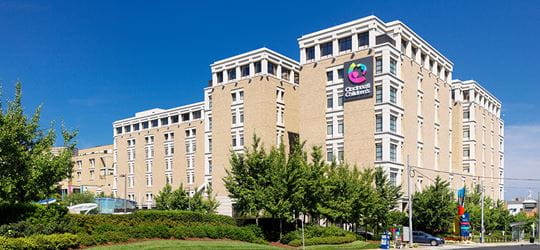
Neha R. Santucci, MBBS, MD
- Director, Disorders of Gut-Brain Interaction Program at the Neurogastroenterology and Motility Center
- Associate Professor, UC Department of Pediatrics
- neha.santucci@cchmc.org
- Board Certified
About
Biography
I’m a physician and scientist whose clinical and research activities focus on neurogastroenterology, including motility and functional gastrointestinal disorders (FGIDs).
I became a pediatric clinician and researcher because childhood illnesses take such a large toll on function, quality of life and family dynamics. I want to play a role in alleviating patient and caregiver struggles. In my clinical practice, I diagnose motility disorders, teach children and their families how to cope with chronic illness and prepare them for the eventual transition from pediatric to adult gastroenterology care. I also work closely with other pediatric specialists at Cincinnati Children’s; together we use a multidisciplinary approach to provide patient-centered care.
My research interests include irritable bowel syndrome, functional dyspepsia, abdominal migraine and functional abdominal pain not otherwise specified. Because current pharmacologic treatments for FGIDs are suboptimal, we’re looking at ways to improve care using a biopsychosocial approach. To that end, I’m studying the effects of sleep and other biopsychosocial influences on pain and the effects of neurostimulation on chronic pain.
Outside of my clinical, scientific and teaching duties, I’m a member of the Center for Understanding Pediatric Pain, the North American Society for Pediatric Gastroenterology, Hepatology and Nutrition (NASPGHAN), and the American Neurogastroenterology and Motility Society (ANMS). I am also the vice chair of the NASPGHAN Integrative Medicine Special Interest Group.
MBBS: Seth GS Medical College and King Edward Memorial Hospital, Mumbai, India, 2009.
Residency: General Pediatrics, State University of New York at Buffalo, Buffalo, NY.
MD: State University of New York at Buffalo, Buffalo, NY, 2014.
Clinic Fellowship: Pediatric Gastroenterology, Hepatology and Nutrition, Louisiana State University, Children's Hospital of New Orleans, New Orleans, LA.
Certifications: American Board of Pediatrics, 2014; Education Committee for Foreign Medical Graduates (ECFMG), 2009.
Interests
Pediatric gastroenterology; neurogastroenterology and motility disorders; functional gastrointestinal disorders (FGID)
Services and Specialties
Location
Insurance Information
Cincinnati Children's strives to accept a wide variety of health plans. Please contact your health insurance carrier to verify coverage for your specific benefit plan.
Publications
Repeat round of auricular percutaneous electrical nerve field stimulation for pediatric disorders of gut brain interaction. Journal of Pediatric Gastroenterology and Nutrition. 2025; 81:234-245.
Auricular Allodynia is Associated With Worse Outcomes in Children With Functional Abdominal Pain Disorders Using Neurostimulation. Neuromodulation. 2025; 28:840-846.
1047 Children and Adolescents with Gut-Brain Disorders Have Worse Sleep Apnea Indices, Sleep Arousals, and Periodic Limb Movements Than Healthy Children. Sleep. 2025; 48:a453.
Mo2133: HIGH PREVALENCE OF MENTAL HEALTH COMORBIDITIES IN CHILDREN WITH ACUTE RECURRENT AND CHRONIC PANCREATITIS. Gastroenterology. 2025; 169:s-1294-s-1295.
Sa2095: A CONSENSUS STATEMENT AND PRACTICAL CONSIDERATIONS ON USE OF PERCUTANEOUS ELECTRICAL NERVE FIELD STIMULATION IN TREATING PEDIATRIC DISORDERS OF GUT-BRAIN INTERACTION. Gastroenterology. 2025; 169:s-648-s-649.
725: PENFS IMPROVES GASTROINTESTINAL AND PSYCHOLOGICAL OUTCOMES IN CHILDREN AND ADOLESCENTS WITH ATTENTIONDEFICIT/HYPERACTIVITY DISORDER AND DISORDERS OF GUT-BRAIN INTERACTION. Gastroenterology. 2025; 169:s-166-s-167.
Mo1706: AURICULAR NEUROSTIMULATION IMPROVES ABDOMINAL PAIN, NAUSEA, PSYCHOLOGICAL FUNCTIONING AND SLEEP IN PATIENTS OVER 18 YEARS OF AGE. Gastroenterology. 2025; 169:s-1173-s-1174.
Sa2098: TRANSITIONS OF CARE: EVALUATING THE ASSOCIATION BETWEEN PEDIATRIC FUNCTIONAL CONSTIPATION AND CHRONIC IDIOPATHIC CONSTIPATION IN YOUNG ADULTS. Gastroenterology. 2025; 169:s-649-s-650.
Mo1401: DISORDERS OF GUT-BRAIN INTERACTION AS SOURCES OF UNRESOLVED SYMPTOMS IN PEDIATRIC PATIENTS WITH EOSINOPHILIC ESOPHAGITIS. Gastroenterology. 2025; 169:s-1122-s-1123.
Sa1226: AURICULAR PERCUTANEOUS ELECTRICAL NERVE FIELD STIMULATION IMPROVES PERSISTENT ABDOMINAL PAIN AND NAUSEA IN PATIENTS WITH EOSINOPHILIC GASTROINTESTINAL DISORDERS. Gastroenterology. 2025; 169:s-403-s-404.






Patient Ratings and Comments
All patient satisfaction ratings and comments are submitted by actual patients and verified by a leading independent experience management company, Qualtrics. Patient identities are withheld to ensure confidentiality and privacy. Only those providers whose satisfaction surveys are administered through Cincinnati Children’s Hospital Medical Center are displayed. Click here to learn more about our survey